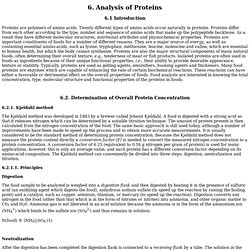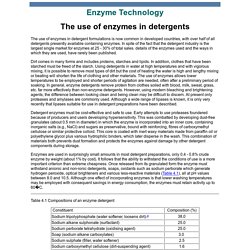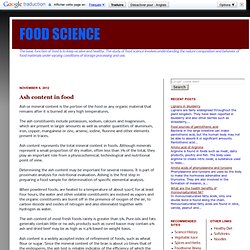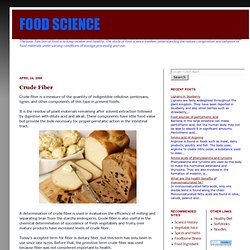

DETERMINATION OF MOISTURE AND TOTAL SOLIDS. 3.

6. ANALYSIS OF PROTEINS. 6.

Analysis of Proteins 6.1 Introduction. Full text of "AOAC: Official Methods of Analysis (Volume 1)" The use of enzymes in detergents. Enzyme Technology The use of enzymes in detergent formulations is now common in developed countries, with over half of all detergents presently available containing enzymes.

In spite of the fact that the detergent industry is the largest single market for enzymes at 25 - 30% of total sales. details of the enzymes used and the ways in which they are used, have rarely been published. Dirt comes in many forms and includes proteins, starches and lipids. In addition, clothes that have been starched must be freed of the starch. Using detergents in water at high temperatures and with vigorous mixing, it is possible to remove most types of dirt but the cost of heating the water is high and lengthy mixing or beating will shorten the life of clothing and other materials. Detergent enzymes must be cost-effective and safe to use. Enzymes are used in surprisingly small amounts in most detergent preparations, only 0.4 - 0.8% crude enzyme by weight (about 1% by cost). Home | Back | Next. Soaps & Detergents: Manufacturing. Soaps & Detergents: Manufacturing Soap and detergent manufacturing consists of a broad range of processing and packaging operations.

The size and complexity of these operations vary from small plants employing a few people to those with several hundred workers. Products range from large-volume types like laundry detergents that are used on a regular basis to lower-volume specialties for less frequent cleaning needs. Cleaning products come in three principal forms: bars, powders and liquids. Some liquid products are so viscous that they are gels. Let's start by looking at bar soap manufacturing and then we'll review the processes used to make powder and liquid detergents.
Different Types of Fermentation: The Difference Between Wild Fermentation and Lactofermentation. We’ve been talking to a lot of people who want to try preserving (or different types of preserving) lately and have found there are a few reasons that motivated people (i.e. people that want to try it) stay away: fear and confusion.

We hope that sharing what we do will help people overcome the fear but realize that there are times that we’ve missed explaining some of the basics that really confused us (and still do from time to time) will help. One of my all-time biggest confusions was around words that seemed dreadfully similar: FermentingWild FermentingNatural FermentingFermenting with a starterLactofermenting There were other such terms but you get the basic idea.
The confusion is common and understandable. Evaluation and Optimization of Critical Control Points in the Production of Iru. Introduction Fermented foodstuffs and condiments are very popular in Nigeria.

Prominent among the soup condiments is iru, a fermented vegetable protein from locust bean seeds (Parkia biglobosa). ANALYSIS OF ASH AND MINERALS. 4.

Analysis of Ash and Minerals 4.1 Introduction The ash content is a measure of the total amount of minerals present within a food, whereas the mineral content is a measure of the amount of specific inorganic components present within a food, such as Ca, Na, K and Cl. Determination of the ash and mineral content of foods is important for a number of reasons: Nutritional labeling. 4.2.
Ash is the inorganic residue remaining after the water and organic matter have been removed by heating in the presence of oxidizing agents, which provides a measure of the total amount of minerals within a food. 4.2.1. As with all food analysis procedures it is crucial to carefully select a sample whose composition represents that of the food being analyzed and to ensure that its composition does not change significantly prior to analysis. 4.2.2.
FOOD SCIENCE: Ash content in food. Ash or mineral content is the portion of the food or any organic material that remains after it is burned at very high temperatures.

The ash constituents include potassium, sodium, calcium and magnesium, which are present in larger amounts as well as smaller quantities of aluminum, iron, copper, manganese or zinc, arsenic, iodine, fluorine and other elements present in traces. Ash content represents the total mineral content in foods. Although minerals represent a small proportion of dry matter, often less than 7% of the total, they play an important role from a physicochemical, technological and nutritional point of view. Determining the ash content may be important for several reasons. FOOD SCIENCE: Crude Fiber. Crude fiber is a measure of the quantity of indigestible cellulose, pentosans, lignin, and other components of this type in present foods.

It is the residue of plant materials remaining after solvent extraction followed by digestion with dilute acid and alkali. These components have little food value but provide the bulk necessary for proper peristaltic action in the intestinal tract. FOOD SCIENCE: Crude Fiber. Crude Fiber. Crude%20Fat%20Determination%20-%20Soxhlet%20Method%20-%201998. Locust beans: Nutritious and medicinal. •Locust beans By Oladele Ogunsola In the South East, you get ogiri (sometimes made from fermented pumpkin seed); in the South West, have iru; and in the North, you have dawadawa.

Whichever region of Nigeria you go, you are sure to get a nutritional and medicinal seasoning. Locust bean, commonly referred to as iru, is a local seasoning used in soups and stews. A very popular soup ingredient, especially among the elderly women, globally, it is referred to as African locust bean with botanical name as Parkia biglobosa. Before the advent of modern seasonings like bullion cubes, it was such a condiment that could not be done without. The product is obtainable from a perennial tree legume which plays an important part in traditional agriculture, but has not entered commercial trade to any significant extent.
Nutritional composition of the African locust bean ( Parkia biglobosa ) fruit pulp. Food science. This is the old United Nations University website. Visit the new site at. Controlled fermentation and preservation of UGBA ¿an indigenous Nigerian fermented food. Effects of Fermentation on Nutrient Enrichment of Locust Beans (<I>Parkia biglobosa</I>, Robert bam) The genus Parkia to which the locust beans belong is large in the family leguminoseceae. The pods are flat, large, irregular clusters from which the locust bean seeds are obtained (Omafuvbe et al., 2004) The species of the genus include Parkia filicoidea, Parkia biglobosa, Parkia bicolor and Parkia clappertoniana. The seeds of P. biglobosa and P. filicoidea had been successfully fermented for the production of food condiments in seasoning foods in Nigeria and other West African countries.
The locust bean tree is planted mainly because the fruit is rich and provides valuable protein in the dry season (Odunfa, 1986). It is also used for medicinal purposes and as a source of mouth wash to relieve toothache. The bean husk (seed coat) are used with indigo dye to improve the luster of fabrics while the tree bark yield a red tannin for dying leather. DSpace at My Futa: NUTRITIVE VALUE AND ANTIOXIDANT PROPERTIES OF CONDIMENTS PRODUCED FROM AFRICAN LOCUST BEAN (PARKIA BIGLOBOSA) Processing and fermentation of the african locust bean (Parkia filicoidea Welw.) to produce dawadawa - Ikenebomeh - 2006 - Journal of the Science of Food and Agriculture.
Evaluation of Biochemical Deterioration of Locust Bean Daddawa and Soybean Daddawa-Two Nigerian Condiments. Base Record. Combination of culture-independent and culture-dependent molecular methods for the determination of bacterial community of iru, a fermented Parkia biglobosa seeds. Introduction Fermented vegetable protein seeds used for condiments production in West Africa include African locust bean [Parkia biglobosa (Jacq.
Benth)], melon seeds [Citrullus vulgaris (Schrad)], castor oil seeds (Ricinus communis), fluted pumpkin seeds (Telfaria occidentale), African yam bean (Stenophylis stenocarpa), cotton seeds [Gossypium hirsitium (L.)], roselle seeds (Hibiscus sabdariffa), and baobab seeds [Adansonia digitata (L.)] (Odunfa and Oyewole, 1998; Ouoba et al., 2008; Parkouda et al., 2010). 2.Biodiversity of Aerobic Endospore-Forming Bacterial Species Occurring.
Fermentation in food processing. Fermentation in food processing is the conversion of carbohydrates to alcohols and carbon dioxide or organic acids using yeasts, bacteria, or a combination thereof, under anaerobic conditions. Fermentation usually implies that the action of microorganisms is desirable. The science of fermentation is also known as zymology or zymurgy. The term "fermentation" is sometimes used to specifically refer to the chemical conversion of sugars into ethanol, a process which is used to produce alcoholic beverages such as wine, beer, and cider.
Untitled Document. Fermentation. Fermentation in progress: Impurities formed by CO2 gas bubbles and fermenting material. Overview of ethanol fermentation. One glucose molecule breaks down into two pyruvates (1). The energy from this exothermic reaction is used to bind inorganic phosphates to ADP and convert NAD+ to NADH.
The two pyruvates are then broken down into two Acetaldehyde and give off two CO2 as a waste product (2). The two Acetaldehydes are then converted to two ethanol by using the H+ ions from NADH; converting NADH back into NAD+ (3). Fermentation is a metabolic process that converts sugar to acids, gases and/or alcohol.